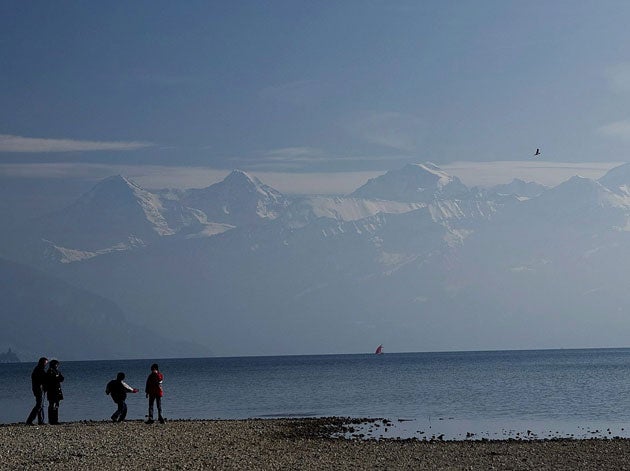Switzerland's explosive war effort threatens environmental disaster
Deformed fish are being landed and served as sightseers flock to view toxic Second World War munitions raised from the floor of Lake Thun

Down at the bottom of Switzerland's deepest lake is one of the country's murkiest secrets. For here is disturbing evidence of Switzerland's little-known Second World War defence effort. It poses a potentially devastating threat to the Alpine nation, 70 years after the conflict.
The placid waters of Lake Thun spread out for 11 miles beneath Faulensee village. Some 700 feet beneath the surface more than 9,000 tons of Swiss army munitions lie dumped on its watery floor. The ordnance includes artillery shells, hand grenades, and explosives that were meant to defend Switzerland against a Nazi invasion that never happened. After the war, the army began a 20-year process of getting rid of its vast munitions stockpile by dumping most of it into four Alpine lakes, all of which are used to supply drinking water to the surrounding population. Lake Thun, in the central Swiss canton of Bern, took the brunt of the disposal programme, which ended in 1964.
The huge pile of underwater ordnance remained out of sight and minds until about a decade ago when local fishermen began to notice abnormalities in the reproductive organs of the lake's whitefish – one of their chief sources of income. More recently the fishermen, who have seen their catches diminish by some 80 per cent over the past three decades, have been pulling bits of dumped munitions out of the lake with the few fish they still manage to net. Last month a rusting hand grenade was hauled to the surface.
Today, a tiny part of this underwater arms dump has been raised to the surface and is, of all things, a tourist attraction. The huge and immaculately polished Second World War guns would fit a battleship, yet they are hidden behind the walls of four innocent looking barns in an idyllic mountain village. As secret weapons they once formed part of the Swiss Army's elaborate wartime defence system. This summer, however, the massive 10.5cm guns, the barns that camouflage their presence, and the network of tunnels linking them underneath Faulensee have been developed as a tourist attraction and thrown open to the public. "The Faulensee artillery battery is of national and historic importance," says the brochure advertising the site as a "unique" Second World War experience.
Yet the promotional leaflet makes no mention of the rest of the arms. Switzerland's environmentalist Green Party, which holds only a handful of seats in a national parliament dominated by the right-wing Swiss People's Party, is appalled that nothing has been done to remove the munitions: "It is scandalous that this potentially lethal rubbish is still there," said Christine Haesler, the leader of the Greens in Bern Canton. "We have been fighting a fruitless battle with the Swiss military for years to try to get the munitions removed, but the army insists that the remains are not dangerous and that their disposal would be too expensive," she added.
The Swiss are not the only people with an underwater munitions problem. The countries surrounding the Baltic are still trying to deal with the threat posed by 300,000 tons of German wartime munitions that Britain the United States and the then Soviet Union dumped in the sea after the Second World War. Tengis Borisov, a Russian environmental researcher recently warned that the munitions meant that the Baltic faced a disaster "on a scale comparable with Chernobyl".
In Switzerland, however, controversy over the issue of dumped ordnance appears to have been studiously avoided. Four years ago, Ursula Haller, a Thun MP and member of the country's small citizens' democratic party BDP, tabled a parliamentary motion calling for the munitions to be removed from the lakes. She argued that as the ordnance was bound to corrode, toxic substances would leak into the lake and pollute, the water supply and the fish. However, the Swiss defence ministry examined the problem and decided that it would not only be too costly but also too dangerous to attempt to remove the ordnance by the preferred method, which involves freezing the munitions and raising them sealed in block of ice.
Various studies were conducted, by the Swiss water board and the country's fisheries department. Yet all of them insisted that there was no evidence that the dumped munitions were leaking toxins. One study even concluded that the sediment covering the munitions was sealing them off more and more each year and that the threat posed was diminishing as a result.
A fisheries department study found that Lake Thun's plankton was the cause of the deformed gonads in the lake's whitefish. However the study was unable to establish what was affecting the plankton and suggested that further investigation was necessary. Meanwhile fishermen and restaurant owners around Lake Thun argue that the whitefish are quite edible because they have been scientifically tested and because those who eat them don't in any case consume the deformed intestines.
A special commission from Switzerland's parliament rejected Mrs Haller's motion by seven votes to five in 2006. Although the Swiss water board argues that the lake waters must be kept under regular observation and that more studies need to be carried out, the issue now appears to have been quietly forgotten by all but the country's Green Party.
Subscribe to Independent Premium to bookmark this article
Want to bookmark your favourite articles and stories to read or reference later? Start your Independent Premium subscription today.

Join our commenting forum
Join thought-provoking conversations, follow other Independent readers and see their replies